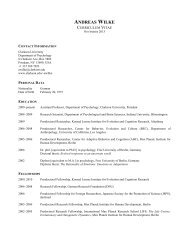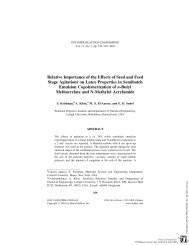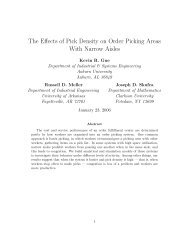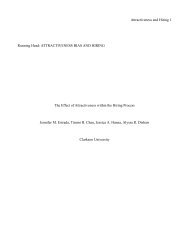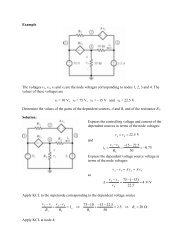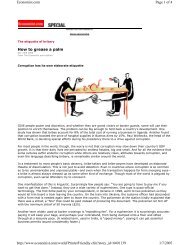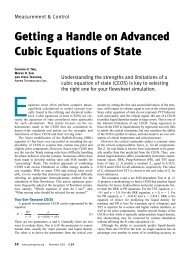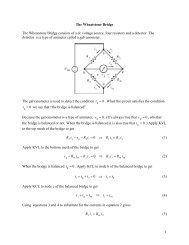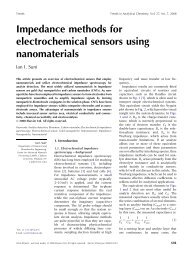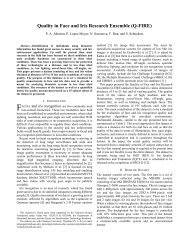Atomic Force Microscopy in Cancer Cell Research - Clarkson ...
Atomic Force Microscopy in Cancer Cell Research - Clarkson ...
Atomic Force Microscopy in Cancer Cell Research - Clarkson ...
You also want an ePaper? Increase the reach of your titles
YUMPU automatically turns print PDFs into web optimized ePapers that Google loves.
<strong>Atomic</strong> <strong>Force</strong> <strong>Microscopy</strong> <strong>in</strong> <strong>Cancer</strong> <strong>Cell</strong> <strong>Research</strong> 3<br />
1.2.2. Tapp<strong>in</strong>g/AC/Intermittent Contact Mode<br />
To further m<strong>in</strong>imize the tip impact onto the surface, dynamic<br />
or <strong>in</strong>termittent contact mode, also commonly known as Tapp<strong>in</strong>g<br />
mode (a trademark of Veeco Instruments, Inc.), was<br />
<strong>in</strong>troduced. Another name use for this mode is AC mode.<br />
In this mode the tip “taps,” or oscillates up and down very<br />
fast, touch<strong>in</strong>g the sample surface for a very short period of<br />
time dur<strong>in</strong>g relatively slow lateral scann<strong>in</strong>g. This considerably<br />
decreases scratch<strong>in</strong>g (although it does not elim<strong>in</strong>ate it<br />
completely). While <strong>in</strong> contact mode cantilever deflection is<br />
detected and measured, <strong>in</strong> this mode the amplitude of oscillation<br />
is typically measured. Positive feedback works <strong>in</strong> a<br />
similar manner to contact mode, by keep<strong>in</strong>g amplitude constant<br />
while scann<strong>in</strong>g.<br />
Pros of <strong>in</strong>termittent contact mode:<br />
• The tip does not scratch the surface, thereby avoid<strong>in</strong>g<br />
artifacts. This is extremely important for soft samples.<br />
• The tip typically does not remove parts of the sample.<br />
• The Tapp<strong>in</strong>g regime allows the collection of various<br />
k<strong>in</strong>ds of <strong>in</strong>formation related to the properties of the<br />
surface material (phase contrast).<br />
Cons of <strong>in</strong>termittent contact mode:<br />
• Successful use of this mode requires extensive operational<br />
skill and additional hardware.<br />
• The load force typically cannot be precisely controlled,<br />
<strong>in</strong> particular <strong>in</strong> liquid environments.<br />
• To atta<strong>in</strong> good imag<strong>in</strong>g quality, expensive cantilevers<br />
must be used.<br />
• The mode does not allow for fast scann<strong>in</strong>g (typically<br />
0.5–2 seconds per scan l<strong>in</strong>e).<br />
Because of its nondestructive scann<strong>in</strong>g, tapp<strong>in</strong>g mode is<br />
a natural choice for the imag<strong>in</strong>g of soft biological surfaces.<br />
It normally requires rather stiff cantilevers (spr<strong>in</strong>g constants<br />
<strong>in</strong> the range of 1 Nm−1 and above).<br />
1.2.3. <strong>Force</strong> Mode<br />
<strong>Force</strong> mode not an imag<strong>in</strong>g mode; it is used to measure<br />
forces act<strong>in</strong>g between AFM tip and the surface of <strong>in</strong>terest<br />
at a specific po<strong>in</strong>t. In contrast to the previous modes, the<br />
cantilever does not move <strong>in</strong> lateral direction. The scanner<br />
goes up and down, elevat<strong>in</strong>g and approach<strong>in</strong>g the cantilever<br />
to the surface. As a result, the image shown <strong>in</strong> Figure 2 is<br />
a typical example of what is recorded. The force F of the<br />
bend<strong>in</strong>g of the cantilever (vertical axis) is plotted aga<strong>in</strong>st<br />
the vertical position z of the sample. When the tip is far<br />
away from the surface, there is no deflection, and consequently,<br />
the force is equal to zero (there is an assumption<br />
of no long-range forces). When the z position of the sample<br />
<strong>in</strong>creases (the sample is moved up by the scanner, Fig. 1),<br />
the tip-sample distance decreases. At some po<strong>in</strong>t, the tip<br />
touches the sample (position of contact). After that, the tip<br />
and sample move up together. This part of the force curve<br />
is called the region of constant compliance. At some po<strong>in</strong>t,<br />
which can be controlled by AFM operator, the sample stops<br />
and retracts down. The force curve before this po<strong>in</strong>t is called<br />
the tip-approach<strong>in</strong>g curve, or simply the approach<strong>in</strong>g curve.<br />
The force curve recorded when the sample is retracted down<br />
is known as the tip-retract<strong>in</strong>g curve, or simply the retract<strong>in</strong>g<br />
curve. Dur<strong>in</strong>g retraction the surface may display non-trivial<br />
Figure 2. A typical force–distance curve recorded by AFM <strong>in</strong> force<br />
mode. Both the approach<strong>in</strong>g and retract<strong>in</strong>g curves are shown.<br />
viscous and elastic properties. This typically results <strong>in</strong> hysteresis<br />
between the approach<strong>in</strong>g and retract<strong>in</strong>g curves, as<br />
shown <strong>in</strong> Figure 2.<br />
One more <strong>in</strong>terest<strong>in</strong>g feature of the retract<strong>in</strong>g curve is<br />
the non-zero force required to disconnect the tip from the<br />
surface. This is the so-called adhesion force. It appears due<br />
to weak short-range forces (such as van der Waals forces)<br />
act<strong>in</strong>g between the tip and surface while <strong>in</strong> contact.<br />
Pros of force mode:<br />
• Provides <strong>in</strong>formation about surface viscoelastic and<br />
elastic properties.<br />
• Also able to detect long-range forces.<br />
• Information about tip-surface adhesion force is<br />
recorded.<br />
Cons of force mode:<br />
• No topographical <strong>in</strong>formation is recorded.<br />
• Requires a very clean, homogeneous surface. Samples<br />
placed <strong>in</strong> biological buffers cannot be this clean.<br />
Moreover, biological surfaces are typically <strong>in</strong>tr<strong>in</strong>sically<br />
heterogeneous. To get reliable force <strong>in</strong>formation, one<br />
needs to collect and analyze a large amount of force<br />
curves.<br />
It is important to note about this mode that the absolute<br />
value of the force can be calculated with high precision.<br />
However, only the relative position of the sample can be<br />
well def<strong>in</strong>ed on the soft samples. This appears because of<br />
ambiguity <strong>in</strong> the def<strong>in</strong>ition of the tip-surface contact.<br />
To measure surface mechanics, one needs to choose a<br />
cantilever with the right spr<strong>in</strong>g constant, which should be of<br />
the same order of magnitude as the surface stiffness (surface<br />
spr<strong>in</strong>g constant).<br />
1.2.4. <strong>Force</strong>–Volume Mode<br />
This mode was <strong>in</strong>troduced [51] to solve the problems of<br />
force mode, described just above. As was noted <strong>in</strong> the previous<br />
section it is useful to simultaneously record the topology<br />
of the surface and force curves. Moreover, it is important<br />
to do multiple measurements to get reliable statistics. The



